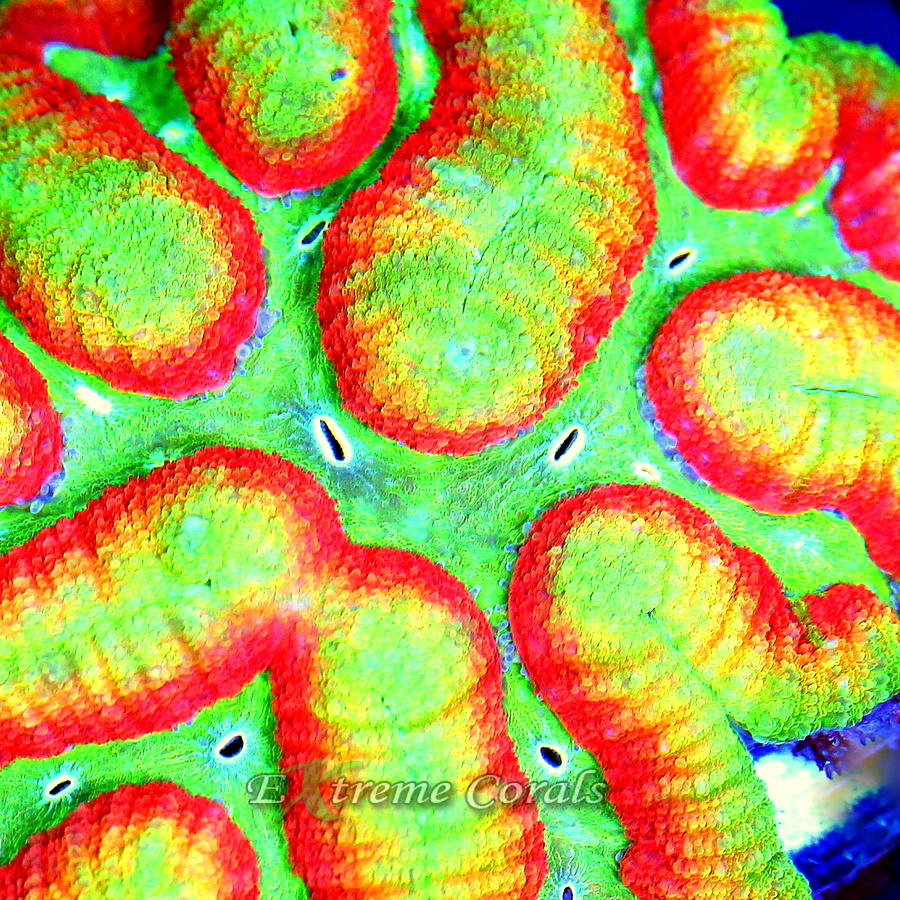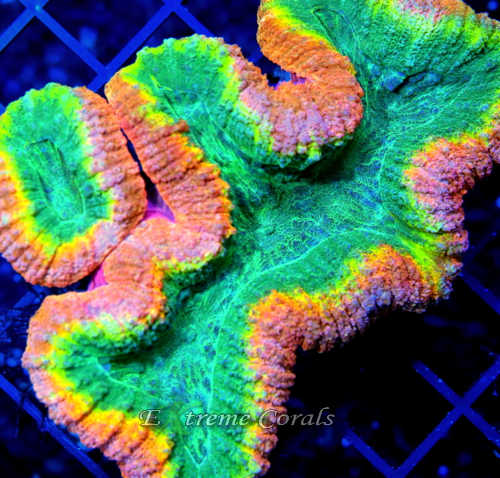Extreme Corals News and Updates
Lobophyllia Care Tips: Maintaining Color and Health in Your Coral Setup
Unlocking the Beauty: A Comprehensive Guide to Lobophyllia Coral Care and Maintenance
Unlock the secrets of Lobophyllia coral care with our in-depth guide. From tank conditions to feeding habits, master the essentials for vibrant colors and thriving marine life in your aquarium.
by scott Shiles • March 15, 2024
Introduction to Lobophyllia corals
Lobophyllia corals, an LPS (Large Polyp Stony) commonly known as "Lobo" in the reef-keeping community, are a popular choice for both beginner and experienced hobbyists due to their vibrant colors and relative ease of care. These corals can be found in various color variations, including shades of green, purple, and red, making them a beautiful addition to any coral setup. Lobo corals thrive in well-maintained aquariums with stable water parameters and moderate to high lighting. When properly cared for, they can grow and spread, adding a stunning visual appeal to your aquarium.

Ideal tank conditions for Lobophyllia corals
Lobophyllia corals thrive in medium to high light, with indirect flow. Ideal water parameters for Lobophyllia corals include a temperature between 75-82°F, pH levels between 8.1-8.4, and salinity at 1.023-1.025. It is important to maintain stable water conditions and avoid sudden changes to prevent stress and ensure the health and vibrancy of your Lobophyllia corals.
Water parameters and quality
Maintaining proper water parameters is crucial for the health and color of your lobophyllia coral. Here are some essential tips to ensure the best water quality for your coral setup:
- Temperature: Keep the water temperature stable within the range of 75°F to 82°F to avoid stressing the coral.
- Salinity: Maintain a specific gravity of 1.024 – 1.026 to provide the ideal salt concentration for your coral.
- pH Level: Aim for a pH level between 8.1-8.4 to prevent acidity or alkalinity from adversely affecting the coral.
- Alkalinity and Calcium Levels: Regularly monitor and adjust the alkalinity and calcium levels to provide a stable environment for the growth and coloration of the lobophyllia coral.
- Nitrate and Phosphate Levels: Keep nitrate levels below 5 ppm and phosphate levels as close to 0 as possible to prevent algae overgrowth and maintain coral health.
Remember, maintaining optimal water parameters is critical for the overall well-being of your lobophyllia coral.
Lighting requirements for Lobophyllia corals
Lobophyllia corals need moderate to high lighting to thrive. LED lights are ideal for these corals as they can produce the necessary intensity without generating excessive heat. Make sure to place the corals in a well-lit area within the tank to ensure they get the light they need. Avoid placing them too close to the light source, as this can cause bleaching and damage to the coral.
Feeding and nutrition tips
Lobophyllia corals mainly feed on small crustaceans and plankton. You can provide them with proper nutrition by feeding them with formulated coral foods containing plankton, krill, and fish oil. It's important to feed your Lobophyllia corals 2-3 times a week, ensuring they receive adequate nutrition for color and health maintenance. Overfeeding should be avoided as it can lead to water quality issues. Additionally, maintaining stable water parameters and proper lighting are crucial for the overall health of your Lobophyllia corals.
Common health issues and solutions
Lobophyllia corals can be prone to common health issues like tissue recession, loss of color, and overgrowth of algae. To maintain your coral's health and color, it is crucial to implement the following solutions:
- Tissue Recession: Ensure stable water parameters, especially alkalinity and calcium levels. Provide moderate to high water flow to prevent detritus buildup, which can contribute to tissue recession.
- Loss of Color: Optimize lighting and ensure proper water flow to prevent shading. Regularly monitor and maintain water quality by testing for nitrate and phosphate levels to keep them at appropriate levels.
- Overgrowth of Algae: Control nutrient levels in the water by using a protein skimmer and regular water changes. Introduce algae-eating organisms, such as hermit crabs or snails, to help keep algae growth in check.
Handling and placement in the aquarium
When handling Lobophyllia corals, it's important to do so gently and with care to avoid damaging their delicate structures. Here are some tips for proper handling and placement in your aquarium:
- Use soft, silicone-tipped coral tongs or your hands to carefully place the coral in the desired location within your aquarium. Avoid touching the coral with sharp or hard objects that could cause damage.
- Ensure that the coral is securely attached to a stable surface within the tank to prevent it from being knocked over by strong water currents or the movement of other tank inhabitants.
- Place the Lobophyllia coral in an area of the tank with moderate to low water flow and gentle lighting to help maintain its vibrant color and promote healthy growth.
- Regularly monitor the coral for any signs of stress, such as changes in color or the appearance of tissue recession, and make adjustments to its placement or aquarium conditions as needed.
By following these care tips for handling and placement, you can help your Lobophyllia coral thrive in your aquarium setup.
Fragging and propagation techniques
To maintain the color and health of your Lobophyllia coral setup, you may want to consider fragging and propagation techniques. Fragging your Lobophyllia coral allows you to create new colonies from your existing coral, helping to propagate its growth. It involves carefully cutting a small piece of the coral and attaching it to a new location for it to grow. This process can help you expand your coral setup and enhance the overall health of your tank.
Monitoring and maintaining vibrant colors
To maintain vibrant colors in your Lobophyllia coral, it's essential to ensure proper lighting and water quality. Lobophyllia corals thrive in moderate to high light conditions, so make sure to provide adequate lighting for your setup. Additionally, maintaining stable water parameters, including appropriate levels of calcium, alkalinity, and magnesium, will help support the coral's coloration and overall health. Regular water testing and adjustments, along with careful observation of the coral's response, will allow you to cater to its specific needs.
Conclusion and summary
Alright, to wrap things up, maintaining the vibrant color and overall health of your Lobophyllia coral is essential for a successful coral setup. By paying attention to lighting, water quality, and proper feeding, you can ensure that your Lobophyllia thrives in your aquarium. Regular water testing and maintenance are key to preventing any potential problems and keeping your coral at its best. Remember to keep an eye on any signs of stress or disease and take prompt action as needed. With these care tips, you can enjoy a beautiful and flourishing Lobophyllia coral in your aquarium setup.

